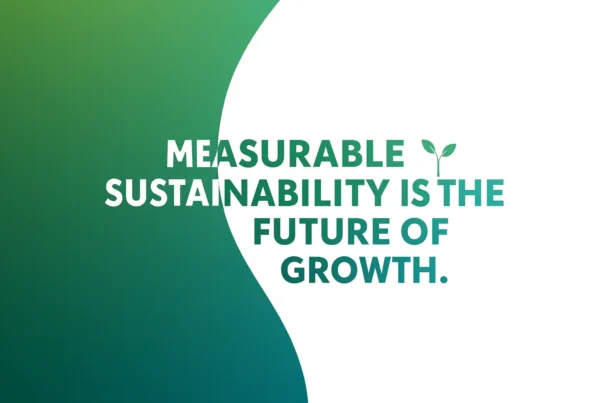Businesses today operate in a world where environmental impact, social responsibility, and transparent governance matter more than ever. Customers expect responsible behavior, investors demand ESG accountability, and regulations are tightening. This is why having a clear corporate sustainability strategy has become essential rather than optional. It guides companies toward long-term value, lower risk, and a stronger reputation.
In this guide, you’ll learn what a sustainability strategy is, why it matters, how to build one, and what modern trends are shaping it.
What Is a Corporate Sustainability Strategy?
A corporate sustainability strategy is a long-term business plan that integrates environmental, social, and governance (ESG) priorities into core decision-making. Instead of running one-off eco-friendly campaigns, a sustainability strategy provides a structured framework for reducing environmental impact, improving social outcomes, and promoting ethical governance.
It connects to three key areas:
-
Environmental: carbon footprint, water use, waste reduction
-
Social: labor practices, community impact, diversity and inclusion
-
Governance: ethics, accountability, transparency
The goal is to embed sustainability inside operations, supply chains, products, and culture.
Key Components of a Strong Sustainability Strategy
A good sustainability strategy includes the following pillars:
1. Leadership & Governance
Sustainability succeeds when the top level of the business treats it as a priority. Boards, CEOs, and senior leaders must set clear expectations and assign responsibilities. Many companies now form sustainability committees to oversee progress.
2. Materiality & Stakeholder Analysis
Not every sustainability issue affects every business equally. A materiality assessment helps identify which risks and opportunities matter most to your stakeholders (employees, customers, regulators, communities).
3. Measurable Goals & Roadmap
Companies need specific, trackable goals—such as net-zero targets, 30% waste reduction, or switching to renewable energy. A roadmap outlines timelines, budget allocation, and team responsibilities.
4. Integration Across the Value Chain
A sustainability strategy must be woven into product design, sourcing, manufacturing, logistics, and customer experience. This is how companies move from surface-level efforts to real impact.
5. Metrics, Measurement & Reporting
ESG reporting standards are becoming stricter. Track performance using KPIs such as emissions, resource efficiency, diversity numbers, and supply-chain compliance. Communicate results transparently through annual sustainability reports.
6. Continuous Improvement
Sustainability is not a one-time project. Markets, regulations, and technologies evolve, so the strategy must evolve too.
Aligning Sustainability with Business Strategy
The leading companies have a totally different approach to environmental sustainability. They see it as a primary element of their business, not something that is added. Apart from this, it must be possible to make up for additional revenues, the creation of new operational resources, the threat of losing them in the long run or gaining a new investor.
A few of such designs are:
- Using green materials in production
- Constructing energy-saving operations to cut down expenses
- Employing sustainability data for marketing and customer trust
- Elevating the transparency of the supply-chain for the avoidance of disruptions
- When everything is set appropriately, sustainability virtually transforms into a more efficient competitive advantage.
Top Trends Shaping Sustainability Strategies Today
Sustainability expectations are rising fast. These are some of the emerging priorities for companies:
-
Stricter regulations related to emissions and reporting
-
Biodiversity and nature-positive commitments, not just carbon reduction
-
Supply-chain transparency, especially around labor and sourcing
-
Circular economy models, such as product reuse and recycling
-
AI-powered sustainability tools for forecasting, monitoring, and compliance
Companies that adapt early reduce risk and build long-term resilience.
Real-World Examples of Strong Sustainability Strategies
Unilever
Unilever has embedded sustainability across product packaging, sourcing, and supply-chain processes. Their Sustainable Living Plan guides everything from reducing plastic waste to sourcing 100% sustainable agricultural ingredients.
Microsoft
Microsoft has committed to becoming carbon negative by 2030. Their strategy includes renewable energy procurement, carbon-removal investments, and sustainability data tracking across operations.
These examples show how a clear sustainability strategy creates measurable impact.
Common Challenges (and How to Overcome Them)
Even with the right intentions, companies often face obstacles:
-
Siloed departments that don’t coordinate
-
Lack of reliable sustainability data
-
Limited budgets
-
Short-term profit pressure
-
Risk of greenwashing
Solutions include improving internal communication, investing in better data systems, starting with small achievable goals, and committing to transparent reporting.
How to Create Your Own Corporate Sustainability Strategy
Here’s a simple step-by-step path:
1. Secure Leadership Buy-In
Make sustainability a top-management priority with clear ownership and accountability.
2. Conduct a Materiality Assessment
Identify the sustainability issues that most impact your business—climate risk, waste, employee well-being, governance, supply chains, etc.
3. Set Clear Sustainability Goals
Use SMART goals (specific, measurable, achievable, relevant, time-bound). Examples:
-
40% carbon-emission reduction by 2030
-
90% supply-chain sustainability compliance
-
Zero waste to landfill
4. Integrate into Day-to-Day Operations
Embed sustainability into:
-
procurement
-
product design
-
logistics
-
HR policies
-
investment decisions
5. Monitor, Report, and Adjust
Track progress using KPIs and annual sustainability reports. Modify the strategy as new challenges emerge.
FAQs
What is a corporate sustainability strategy?
It is a long-term framework that integrates environmental, social, and governance priorities into a company’s operations and decision-making.
How is a sustainability strategy different from CSR?
CSR is often philanthropic or community-focused, while a sustainability strategy is a structured business roadmap tied directly to performance, operations, and long-term value.
What metrics should companies track?
Common KPIs include carbon emissions, water usage, waste reduction, employee well-being, supplier compliance, and governance indicators.
How often should it be updated?
Most companies update their sustainability strategy annually or whenever major changes occur in regulations, risks, or market conditions.
Can small businesses build a sustainability strategy?
Yes. Start with small goals—energy efficiency, waste reduction, ethical sourcing—and expand as resources grow.
Conclusion
An efficiently constructed sustainability was made possible through the technology of a corporate sustainability strategy. The strategy not only aids businesses in being responsible and avoiding risks but also creates long-term value. Businesses can do meaningful things such as operating sustainably, monitoring their performance and adopting sustainability, which can have positive effects on their competitiveness. The key move towards everything is to begin and correct it according to the company’s development.



